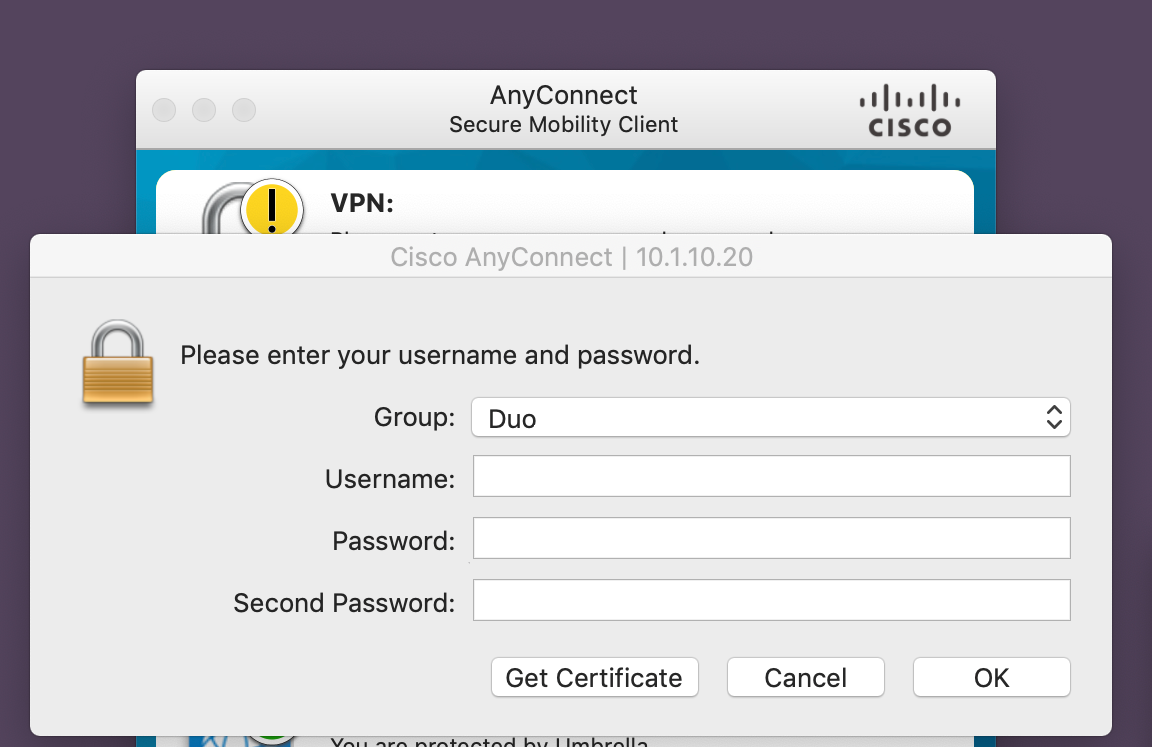

- Cisco anyconnect secure mobility client not working update#
- Cisco anyconnect secure mobility client not working password#
- Cisco anyconnect secure mobility client not working download#
We have seen reports of tunnel drops specifically within the first few minutes after connecting to the MX.ġ. Scenario Seven: Tunnel drops intermittently

The Root CA certificate can then be downloaded from the internet and pushed to the client To identify what Root CA to download, try connecting to the DDNS hostname or IP of the MX, when the Untrusted Server message pops up, click details, look at the Issuer field to identify the Root CA required.
Cisco anyconnect secure mobility client not working download#
In rare cases, you may need to download the Root CA certificate and push it to the end device in order for it to trust the An圜onnect Server certificate.
Cisco anyconnect secure mobility client not working update#
If you do not see the HydrantID certificates, you should update your browser to the latest version If this is seen on some devices, check the Trusted CA folder on your client device.
Connect to the MX with different devices to see if they all report the MX as an “Untrusted Server.” Devices should have HydrantID Server CA O1 certificates by default. Connecting with the IP will throw off certificate error even if there is a publicly trusted certificate on the MX Ensure you are connecting with the DDNS hostname not the IP of the MX. Ensure Dynamic DNS is enabled and resolves to the MX IP. What if the user continues to get an "Untrusted Server Certificate" message 10 minutes after the An圜onnect was enabled? If you try to make a connection before a publicly trusted certificate is available, you will see the “Untrusted Server Certificate” message. Once the public certificate enrollment is complete, the An圜onnect server will swap out the self-signed certificate with the publicly trusted certificate. Then the MX initiates enrollment for a publicly trusted certificate this will take about 10 minutes after An圜onnect is enabled for the certificate enrollment process to be completed. When An圜onnect is configured on your MX, it generates a temporary self-signed certificate to start receiving connections. Verify you are connecting to the right device via the right public IP/Port or hostname. This error is seen when certificate authentication is enabled and none of the certificates presented by the authenticating client match or was issued by the certificate uploaded to the MX for certificate authentication.Ĭheck the Personal > Certificates folder of the client to verify that there is a valid certificate that was issued by the Trusted CA certificate uploaded to the Dashboard for certificate authentication. Take a packet capture on LAN/VPN/WAN depending on where the authentication server resides to see if authentication requests and replies are seen been the MX and the authentication server. Ensure your MX is listed as a RADIUS client, if authenticating via RADIUS. Ping the RADIUS or AD server to see if it is online. You may even see error messages indicating an issue with the server certificate, although the issue really is that the Active Directory or RADIUS server did not respond to the authentication request. If the user does not get a prompt to reenter their credentials, the server is not responding or the response from the server is not making it back to the MX for some reason. Cisco anyconnect secure mobility client not working password#
When the RADIUS or AD server responds immediately with authentication failure, the user will get a prompt to reenter their password immediately.

When authenticating with RADIUS or Active Directory (if offline), after entering your username and password, your An圜onnect client will look like screenshots below. Authentication server is down or not responding. Look at the event log and filter by "An圜onnect authentication failures" and try testing with different username and password or try updating your credentials.Ĥ. A possible workaround is to disable captive portal detection under the An圜onnect client preferences. This error message is usually seen when there is a captive portal enabled on the network the user is connecting from. This error message is seen when a user tries to connect with an An圜onnect client version 4.7 or lower. The MX only supports TLS 1.2, hence you need An圜onnect client version 4.8 or higher to connect to the MX (An圜onnect server).

Wrong An圜onnect client version: You receive the error message “The An圜onnect package on the secure gateway could not be located" when authenticating.








 0 kommentar(er)
0 kommentar(er)
